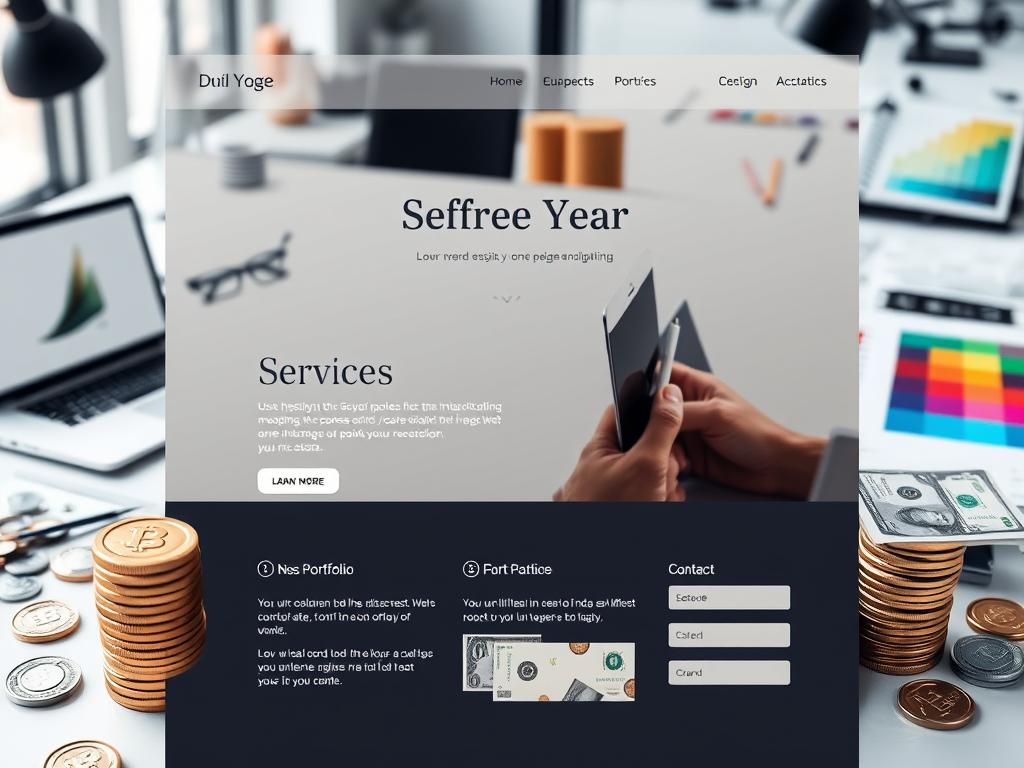Having an online presence has become crucial in the digital age for both individuals and companies. As the address for your website, obtaining a domain name is one of the first steps in this process. Although many people are aware that buying a domain can be expensive, free domains are a good substitute. For individuals who are just getting started, these domains may be a compelling choice, whether they are establishing a portfolio website, small business, or personal blog.
Key Takeaways
- Free domains are a cost-effective option for individuals and small businesses looking to establish an online presence without the financial commitment of a paid domain.
- While free domains offer initial cost savings, they come with limitations such as limited customization, branding restrictions, and potential for downtime.
- Options for free domains include subdomains, third-party domain providers, and website builders that offer free domain hosting.
- Researching free domain providers is crucial to ensure reliability, customer support, and additional features such as email hosting and security measures.
- When choosing the right free domain, consider factors such as branding opportunities, scalability, and the ability to upgrade to a paid domain in the future.
A free domain is appealing because there are no up-front expenses and you can experiment and learn about web development without worrying about money. Despite the allure of the free domain concept, it is important to comprehend what it means. Your internet presence may be impacted by the limitations and restrictions that free domains frequently have. The different facets of free domains, such as their restrictions, available options, and how to select and manage one efficiently, will be covered as I go deeper into this subject. By the time this post is over, I want you to have a thorough understanding of free domains, enabling you to make wise choices regarding your online experience.
Although free domains are a great place for many people to start, they do have some disadvantages. The absence of authority over the domain name itself is a major drawback. Instead of offering distinct domain names, a lot of free domain providers provide subdomains. For example, rather than having a customized domain like “mywebsite . com,” I might wind up with “mywebsite .
provider . com.”. This could make it more difficult for users to remember my website and damage the credibility of my brand. Also, using a subdomain may confuse users and make them doubt the authenticity of my website. Another drawback is the possibility of domain provider branding and advertisements. By including their branding in the URL or placing advertisements on users’ websites, a lot of free domain services make money off of their offerings.
The user experience may suffer as a result, and potential visitors may decide to leave. Also, compared to premium options, free domains frequently have fewer features and less customer support. Free domains can be a helpful tool for experimentation, but they might not be appropriate for long-term projects or professional endeavors, as I discover when I work through these limitations. Investigating my options is crucial when thinking about free domains.
Free domain registration is provided by a number of platforms, each with special features and restrictions. Popular options include Wix, Weebly, and WordPress.com. Along with free subdomains as part of their service, these platforms give users an intuitive interface for creating websites. These platforms can greatly simplify the web development process for someone like me who is just getting started.
Apart from website builders, there are also services that offer domain names with particular extensions for free. Freenom, for instance, provides free domains with extensions such as . tk, . ml, .
ga, . cf, & . gq. Even though these options are free, I have to think about whether they will project the professionalism I want for my online presence. Thinking about my long-term objectives and how a free domain fits with them is essential as I consider my options.
I must do extensive research to make sure I select a trustworthy service before deciding on a free domain provider. This entails examining user reviews & testimonials to determine how other platform users have experienced the platform. Users’ experiences with uptime, customer service, or potential hidden costs are what I’m interested in knowing. To find out what rights I have over my domain and how my data will be handled, I should also look into the terms of service & privacy policies of possible providers.
Examining the features and restrictions of free domain providers is another crucial component of the research process. Certain platforms might provide more tools for managing and creating websites, or they might offer more customization choices than others. For example, I should search for providers who support e-commerce features even in their free plans if I intend to add them to my website in the future. I can make an informed choice that fits with my needs & goals if I take the time to carefully investigate different providers.
It’s important to carefully consider my unique needs and objectives when selecting a free domain. I have to consider my website’s goal first and foremost. I might rank different features of a free domain according to my response: is it a professional portfolio displaying my work, or is it a personal blog where I share my ideas and experiences? For example, having a more professional-sounding domain name—even if it’s a subdomain—might be crucial if I’m trying to develop my personal brand or draw in new customers. I should also think about how my decision will affect things in the future.
Even though a free domain might work well for me at first, I should consider scalability and future expansion. It would be prudent to pick a provider that offers simple upgrades & migration options if I plan to grow my website or switch to a paid plan in the future. I can choose a free domain that not only fits my needs now but also advances my ambitions as I develop online by carefully assessing my needs and long-term objectives. Creating a Free Domain Account.
The next step is to register the free domain after you’ve decided on a provider & found the ideal one for your requirements. Usually, the registration process is simple, & most platforms have user-friendly interfaces that walk you through each step. It’s imperative to pay attention throughout this process, though, to make sure that all of the information is correct and current. delivering precise information.
Providing accurate contact details is part of this, since some providers might need confirmation before enabling your domain. To prevent any possible problems with the registration process, it is imperative that you verify your contact information. being aware of the terms & conditions.
It’s also crucial to pay attention to any terms and conditions related to the free domain when registering. In certain situations, certain domain providers may restrict your use of the domain or retain the right to cancel it. Gaining an understanding of these terms will help you steer clear of future pitfalls.
finishing the process of registration. Your selected provider will confirm that you successfully finished the registration process, enabling you to proceed with creating your new online presence. Now that I have registered my free domain, it’s time to get it operational. Linking my domain to a content management system (CMS) or website builder allows me to create & manage the content on my website. The majority of providers have user-friendly setup wizards that help me easily link my domain to their platform.
In this step, I typically choose templates & modify them to my liking if I’m using a website builder like WordPress or Wix. I should take into account important components like page layouts, navigation menus, and overall design aesthetics when I set up my website. A well-designed website improves search engine optimization (SEO) in addition to the user experience. Since more and more people are visiting websites on smartphones and tablets, I should also make sure that my website is responsive. I can build an interesting online presence that appeals to visitors by considering these aspects when I set up.
For a free domain to remain functional and relevant, constant care and attention are needed. Frequently updating the content on my website is an essential part of upkeep. In addition to keeping users interested, fresh content tells search engines that my website is active and deserving of a higher ranking in search results. Adding fresh content on a regular basis, whether it be blog entries, portfolio updates, or new product listings, will help me gradually develop an audience.
I must also continue to keep a close eye out for any modifications to my provider’s service terms or possible problems with performance or uptime. Maintaining a good user experience will depend on my ability to quickly address any issues I find or receive notifications about changes that might impact my site’s functionality. Finally, as my requirements change over time, I should periodically review if my current free domain still serves my purposes or if switching to a paid option would allow me more flexibility and control over my online presence. In conclusion, free domains provide a convenient way to get started with web development & online branding, but they have drawbacks that should be carefully considered. Through comprehension of these constraints and investigation of my options, I can make well-informed choices regarding the registration and upkeep of a free domain that corresponds with my objectives and desires in the digital sphere.
If you’re exploring ways to obtain a 100% free domain, you might find the article “Can I Get a Domain for Free?” particularly useful. This article delves into various methods and services that offer free domains, discussing their pros and cons, and providing insights on what to expect when opting for a free domain. It’s an excellent resource for understanding the limitations and opportunities associated with free domain registration.
FAQs
What is a domain name?
A domain name is the address of your website that people type in the browser’s URL bar to visit your website.
How can I get a 100% free domain?
There are some companies that offer free domain names as part of their hosting packages. You can also find some domain registrars that offer free domain names for the first year as a promotion.
Are there any limitations to getting a free domain?
Some free domain offers may come with limitations such as the extension options, renewal fees, or the requirement to purchase a hosting plan. It’s important to read the terms and conditions carefully before choosing a free domain offer.
What are the alternatives to getting a free domain?
If you are unable to find a 100% free domain, you can consider purchasing a domain name from a domain registrar. Prices for domain names can vary depending on the registrar and the domain extension.
Can I transfer my free domain to another registrar?
Some domain registrars may allow you to transfer your free domain to another registrar, but there may be fees involved. It’s important to check the transfer policy of the registrar offering the free domain.







